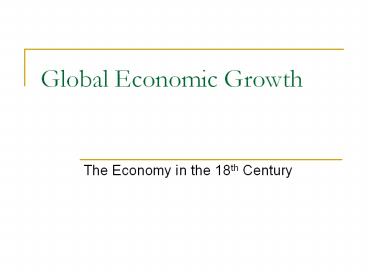Global Economic Growth - PowerPoint PPT Presentation
Title:
Global Economic Growth
Description:
Global Economic Growth The Economy in the 18th Century Population Trends Population Growth: Europe grew from 80 mil to 180 mil from 1500-1700 China 350 mil and India ... – PowerPoint PPT presentation
Number of Views:83
Avg rating:3.0/5.0
Title: Global Economic Growth
1
Global Economic Growth
- The Economy in the 18th Century
2
Population Trends
- Population Growth
- Europe grew from 80 mil to 180 mil from 1500-1700
- China 350 mil and India 200 mil by 1700
- Pop rebounding in Americas
- Ottoman pop stagnated
- Pop growth concentrated people in cities and
pushed them out into undeveloped lands
3
(No Transcript)
4
Urbanization
- China, India, and Japan housed most cities
- Many over 100,000 in population
- Europe had fewer cities, but rapid growth
- London almost 1 mil by 1800
- Paris and Naples ½ mil
- Cities being built in the Americas
- Mexico City
- Lima, Peru
- Boston, Philadelphia, and New York
5
Explanations for Pop. Growth
- End of food monocultures
- Improved transportation networks
- Plague survivors immunology!
- Improved Medicine
6
18th Century Medicine
- Global exchange of medical knowledge
- New medicinal plants and drugs
- Opium, quinine, etc.
- Gradual recession of the humoral theory
- Diet and exercise became focus of medicine
- Scurvy treated with citrus fruit
- Anson expedition lost 1400 of 1900
- Smallpox inoculations
- No idea why it worked
7
(No Transcript)
8
(No Transcript)
9
Poppy Field
10
Chinese Economics in the 18th Century
- China still center of industrial activity
- Textiles silk
- Porcelain
- Paper
- Grain
- Majority of Chinese products for domestic
consumption - Foreign trade not important to Chinese, internal
market - China primarily closed to foreigners, only
allowed to trade at select ports - Favorable trade balance still existed in 1700s
11
(No Transcript)
12
China cont.
- British bring opium to China from India (poppy
plants) - Monopolized by British East India Trading
Company - Finally a product that the Chinese want
- Trade gap begins to shrink
- Chinese gov. tries to ban opium, but demand is
too high - Opium trade grows exponentially over century
- Chinas huge population makes labor cheap
- Reason China fails to mechanize industry
- Europe does mechanize and eventually is able to
outstrip Chinese production
13
Collapse of Indian Industry
- Beginning of century an industry leader
- Different clans and castes specializing in
certain products - Particularly iron and textiles
- Mughal Empire begins to fall in 1700
- Afghan and Persian invaders sack Delhi
- Imperial treasury drained in 1739
- British East India Company begins buying up
assets - British silver stops flowing into India, replaced
by local taxes - British begin extracting resources and exploiting
labor - Slowly assume control of entire country
14
(No Transcript)
15
Ottomans in the 18th Century
- Took on lackadaisical attitude toward trade
- Uninterested in competing with Europe
- Stagnant population growth
- Textile production falls as Europeans took over
Ottoman techniques - Europe begins to dominate shipping in the
Atlantic Ocean
16
(No Transcript)
17
The West in the 18th Century
- Beginnings of the Industrial Revolution
- Europes Scientific Revolution accustomed
Europeans to reliance on unseen forces - Steam
- Magnetism
- Electricity
18
(No Transcript)
19
The Rise of Britain
- Relatively low pop. (9 mil) led to rush toward
industrialization/mechanization - Rich coal reserves fueled industrialization
- Steam power changed steel and textile industries
- Could drop production costs by 50
- Imperial control of Ireland supplied agricultural
surplus to free up workers - Profits of Triangle Trade invested in
infrastructure - British colonies provided captive markets
- End of subsistence ag. and consolidation of land
freed more workers for industrial pursuits - Similar movements take place in Japan and Europe
later in the century
20
(No Transcript)
21
18th Century in Perspective
- Globe caught in a positive feedback loop
- Growing population
- Growing demand
- Growing output
- Growing commerce































